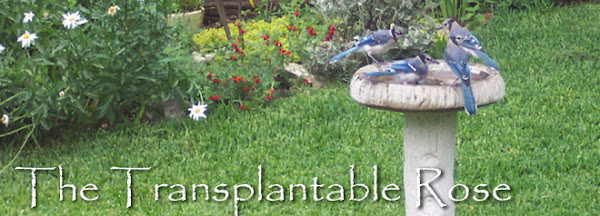What do you think of when you hear "Ginger plant"? The first one that comes to my mind is Hedychium coronarium, the fragrant white-flowering ginger, also called Hawaiian White Ginger or
Butterfly Ginger. I brought a tiny root back from the airport gift shop in Hawaii more than a decade ago and have it growing in a few places in my garden. I can still remember how thrilling it was when my plant first bloomed in 2004.

You can find fancier, named varieties of Hedychium with larger flowers in many colors but I still love the white one... reminds me of the loved and long-discontinued Avon sticks in Hawaiian White Ginger scent.
Each summer I hope for the return of the fragrant blooms - in some years they are few but this year buds have formed on one plant.

Maybe Ginger to you means true, edible ginger, Zingiber officinale? I once started a plant from one of the fresh ginger roots from the produce section but it was very tender and didn't survive. The leaves look similar to my white ginger but it's grown for the root, not the flowers.
Perhaps, like many people in Austin, you think of the large-leaved variegated ginger grown in containers and in the ground. A few years ago I picked up a pot from the bargain table at a big box nursery for a couple of dollars. I'm pretty good about keeping lists of plant purchases, but I didn't even bother to write this one down, sure it was just a tender, one-season foliage plant.
Over the first winter the foliage died back badly but the leaves struggled back up to form a sadly diminished foliage plant that summer.
Its fortitude earned the ginger a place in the garage for Winter 2009-2010, safe from freezes but subject to dust and sawdust.

With the return of warm weather the pot was dragged back onto the front porch.
Then in 2010 my friend Ellen bought a couple of Variegated gingers from the reduced-for-quick sale section at a big HEB store - she brought one to me and I put it in another pot, to have one on each side of the front door.
Both pots of variegated ginger grew and were dragged back in the garage for winter 2011-12.
Last spring they came out front to grow some more. But they didn't grow in quite the same way - one had clusters of leaves on stalks and one sent more pointed leaves sprawling in every direction.
Finally I got the message - these plants were not the same plant.
Ellen's gift was definitely a variegated Shell Ginger, best guess was Alpinia zerumbet 'Variegata'.

But my bargain baby was something else.
It seemed to be some variety of Ctenanthe lubbersiana - maybe just variegata or maybe one of the named varieties. Some sites called it Bamburanta and others Prayer Plant. Some people on GardenWeb called it California Ginger - this seems to be a name used by home centers when they sell Ctenanthe as tropical plants.

By late fall 2012 both plants needed repotting.
After a redo, the Shell Ginger was in a larger decorated pot set in a corner of the porch.

I split the Not-Shell Ginger into two rather gawky plants, one for each side of the door.

When I cut off some stalks with browned leaves, I noticed the way the leaves were attached in small fans at the top of the stalks. I pulled off a few fans and poked them into another pot on the patio, and stuck a few more fans in smaller pots.
My instincts were right - the fans rooted and soon I had a third plant growing with a Blue Butterfly Clerodendron, something that also needed to be in the garage for winter.

This summer the front pots of Ctenanthe/California Ginger look pretty good, under the overhang of the veranda, in partial shade from a large tree.

They need water a few times each week in warm weather, but not every day.
And after a recent grooming session I have more pieces stuck in pots in hope they'll root.
The porch was too small for the Shell Ginger - in back it can get a mix of sun and shade and spread out.

As a foliage plant it is just fine, but now I have higher ambitions for my Shell Ginger! In June some friends and I went on the NXNA garden walk and saw this enormous plant in bloom against a brick wall. Wow!

Two mild winters in a row meant that flower buds on Shell Ginger plants all over Austin didn't freeze but lived to bloom, surprising many of the gardeners who had nurtured them for years without ever seeing a flower. Sometimes patience is rewarded with great beauty.
This post was written by Annie in Austin for her Transplantable Rose blog.






















































